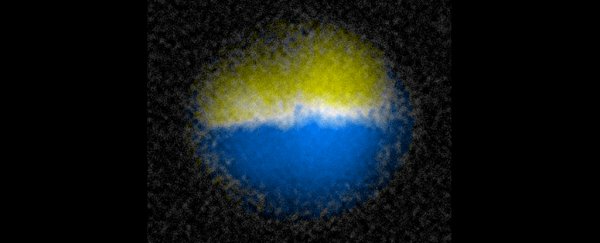Quantum mechanics – the behavior of the Universe at the smallest of scales – continues to surprise us, with scientists now having been able to successfully create a quantum object called a domain wall in laboratory settings.
For the first time, these walls can now be generated in the lab on demand, occurring when atoms stored at very cold temperatures – a scenario known as a Bose-Einstein condensate – group together in domains under certain conditions. The walls are the junctions between these domains.
The researchers creating these domain walls say they could end up shedding new light on many different areas of quantum mechanics, including quantum electronics, quantum memory, and the behavior of exotic quantum particles.
"It's kind of like a sand dune in the desert – it's made up of sand, but the dune acts like an object that behaves differently from individual grains of sand," says physicist Kai-Xuan Yao from the University of Chicago.
There has been previous research into domain walls, but they've never been able to be created at will in the laboratory until now, giving scientists the ability to analyze them in new ways. It turns out they act as independent quantum objects, but not necessarily in the way that scientists would expect them to.
That unexpected behavior means domain walls join a class of objects called emergent phenomena, where particles that join together seem to follow a different set of physics laws than particles that are operating on their own.
One of the unusual observations made by the team is the way that domain walls react to electric fields, something which will need further study to untangle. For now, just being able to produce and manipulate these walls is an important step forward.
"We have a lot of experience in controlling atoms," says physicist Cheng Chin from the University of Chicago. "We know if you push atoms to the right, they will move right. But here, if you push the domain wall to the right, it moves left."
Part of the reason why the discovery is so important is that it could teach us more about how atoms behaved at the very beginning of the Universe's existence: Particles that were once clumped together eventually expanded to form stars and planets, and scientists would like to know exactly how that happened.
This domain wall discovery falls under the umbrella of what's known as dynamical gauge theory – a way to test and compute the dynamics of quantum phenomena in the lab. These discoveries could explain how emergent phenomena operate in everything from materials to the early Universe.
As well as looking backwards though, the researchers are also looking forwards. Once more is understood about how domain walls can be controlled, it could open up opportunities for new quantum technologies.
"There may be applications for this phenomenon in terms of making programmable quantum material or quantum information processors," says Chin.
"It can be used to create a more robust way to store quantum information or enable new functions in materials. But before we can find that out, the first step is to understand how to control them."
The research has been published in Nature.
